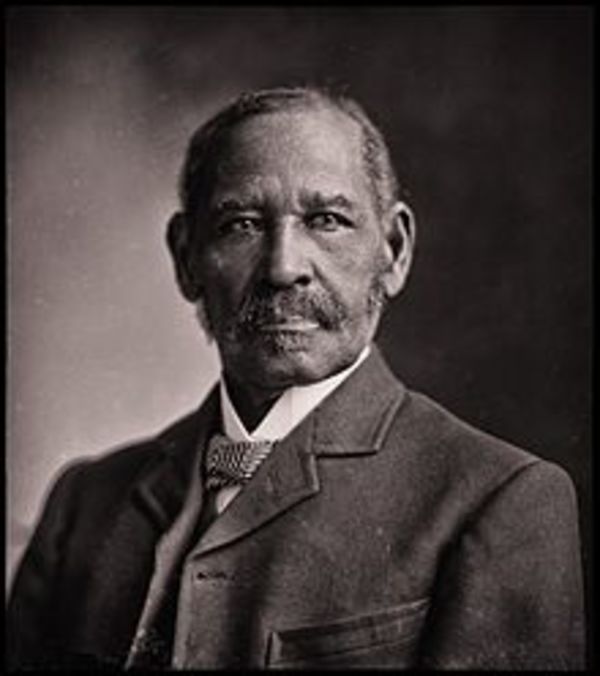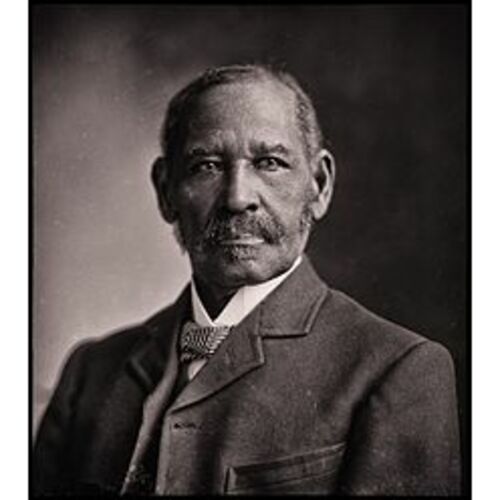
Source: Courtesy of Wikimedia Commons
GIBBS, MIFFLIN WISTAR, businessman and politician; b. 17 April 1823 in Philadelphia, son of Jonathan C. Gibbs, a Wesleyan Methodist minister, and Maria —; m. 1859, possibly in Oberlin, Ohio, Maria Ann Alexander of Kentucky, and they had five children, of whom two sons and two daughters survived to adulthood; d. 11 July 1915 in Little Rock, Ark.
Jonathan C. Gibbs died in 1831, leaving his wife with four small children and little money. Eight-year-old Mifflin Gibbs was sent to work, driving a doctor’s horse at first and eventually becoming a carpenter’s apprentice. In 1839 he joined the Philadelphia Library Company, an African American literary society which included prominent abolitionists, and he soon was involved with the Underground Railroad. While attending a national anti-slavery convention in 1849, Gibbs accepted the invitation of abolitionist Frederick Douglass to accompany him on a lecture tour of western New York state.
At the end of the tour Gibbs left for the California gold-fields. He arrived in San Francisco in September 1850 and by working as a carpenter and bootblack accumulated savings which enabled him to join a clothing business. A year later he became a partner in the firm of Lester and Gibbs, importers of fine boots and shoes. Conditions were deteriorating for the African American community in California, however. Gibbs actively protested against the rising discrimination. He helped to found and publish the Mirror of the Times (San Francisco), which advocated equal rights for all. In 1857 he and his partner, Peter Lester, refused to pay the poll tax since they were not allowed to vote. Some of their goods were seized and put up for auction, although in the event a sympathetic white Southerner persuaded the crowd not to bid.
A year later the black community decided to emigrate. Possible destinations such as Panama and Mexico were discussed, but Vancouver Island was selected, partly because of the news that had just come of the Fraser River gold-rush. The first party of emigrants departed on 20 April 1858. Gibbs himself left in June. He came to Victoria with “a large invoice of miners’ outfits, consisting of flour, bacon, blankets, picks, shovels, etc.,” which he sold immediately. The day after his arrival he bought a one-storey house for $3,000, and it became the site for a mercantile business, reportedly the first outside the Hudson’s Bay Company, which Gibbs operated in partnership with Lester. In 1859 he returned briefly to the United States, and it was on this trip that he married Maria Ann Alexander. They were in Victoria the next year and lived in a house at the corner of Michigan and Menzies streets where all five of their children would be born.
Although it is difficult to ascertain exactly how many blacks migrated to Vancouver Island during the 19th century, the majority of the more than 400 identified so far came from the United States between 1858 and 1860. Their occupations included full-time care-giver, domestic, boarding-house operator, laundress, cook, baker, saloon-keeper, and store and livery-stable owner. Most were in marriages interrupted only by the death of one partner. The threat of American aggression as a result of a dispute over San Juan Island (Wash.) prompted the community to form the Victoria Pioneer Rifle Corps, an all-black volunteer militia of which Gibbs was a member, and a “Committee of Coloured Ladies” raised money both for it and for ex-slaves in the United States. In contrast to what had occurred in California, in British Columbia a separate church was not established, people having decided that it was better to become actively involved in existing local churches instead. The Gibbs and Lester families belonged to the congregation of Christ Church Cathedral.
The community’s push for integration came from a desire to have equal access to institutions, services, and the political process, privileges that had been denied in the United States. Gibbs and 17 other black male property-owners voted en bloc in the 1860 elections for the House of Assembly of Vancouver Island. The candidates they supported, George Hunter Cary* and Selim Franklin, obtained 137 and 106 votes respectively; the defeated third candidate, Amor De Cosmos*, polled 91. After the election Gibbs expressed the community’s satisfaction at finally gaining the vote. De Cosmos, editor of the local British Colonist, launched a bitter campaign against the immigrants, saying that they had sold out themselves, their friends, and their country and were to be blamed for the racism directed towards them. The vote was illegal, he declared, because a majority were not British subjects. Gibbs took issue with De Cosmos’s remarks in a letter to the newspaper stressing the immigrants’ loyalty to the British constitution and their belief in equality. De Cosmos continued with his campaign to have the voters’ list verified, and in March 1861 most of the newcomers were disqualified. Later that year Gibbs became a naturalized British subject in order to register as a voter. Elected to the Victoria city council in 1866, he served two terms in office and was chairman of the finance committee for a time. He eventually resolved his differences with De Cosmos. In 1868 he was the Salt Spring Island delegate to the Yale Convention, where De Cosmos and other members of the Confederation League presented their views on union with Canada.
Involved in other business concerns besides his store, Gibbs was a director of the Queen Charlotte Coal Company. He resigned this directorship in order to bid on a contract from the company and, being successful, left in January 1869 for the Queen Charlotte Islands with 50 men to build a railway and wharves for shipping coal. As a result of his endeavours “the first cargo of anthracite coal ever unearthed on the Pacific seaboard” was sent to San Francisco, he reported.
Maria Ann Gibbs had left Victoria with their children in 1865 and, having settled his financial affairs, Mifflin Gibbs rejoined his family later in 1869 and in 1870 entered the law department of a business college at Oberlin, Ohio. In 1871 he moved to Little Rock, Ark.; he was hired by the law office of Benjamin and Barnes but resigned the next year to form his own firm. An active Republican, he subsequently held various judicial and governmental positions until October 1897, when he was appointed American consul to Madagascar. In 1901 Gibbs returned to the United States and became president of the Capital City Savings Bank, a mainly African American institution located in Little Rock. This position afforded him time for travel, and he visited Victoria in 1907. He died a wealthy man, at his home in Little Rock eight years later.
Mifflin Wistar Gibbs is the author of Shadow and light: an autobiography, with reminiscences of the last and present century (Washington, 1902; repr. New York, 1968).
ACC, Diocese of British Columbia Arch. (Victoria), Christ Church Cathedral, Victoria, reg. of baptisms, 24 Oct. 1860. Arkansas Democrat (Little Rock), 12 July 1915 (copy at the Ark. Hist. Commission, Little Rock). Arkansas Gazette (Little Rock), 24 Aug. 1903, 12 July 1915 (copies at the Ark. Hist. Commission). British Colonist (Victoria), 1859–28 July 1860, continued as the Daily Colonist, 31 July 1860–68, esp. 26–27 Sept., 1, 11, 15 Oct. 1861; 31 Aug. 1907. Sophia Cracroft, Lady Franklin visits the Pacific northwest: being extracts from the letters of Miss Sophia Cracroft, Sir John Franklin’s niece, February to April 1861 and April to July 1870, ed. Dorothy Blakey Smith (Victoria, 1974). Directory, B.C., 1860, 1868. Sherry Edmunds-Flett, “Family and community life of British Columbia’s nineteenth-century African-Canadian women” (paper presented to the CHA, Ottawa, 1993). Eric Foner, Reconstruction: America’s unfinished revolution, 1863–1877 (New York, 1988) [incorrectly states that Gibbs was a councilman in Vancouver]. Government Gazette – British Columbia (New Westminster; Victoria), 1861, 1863–64, 1868 (assessment rolls). [The gazette was published on the last page of the New Westminster British Columbian, 1861–62.] Crawford Kilian, Go do some great thing: the black pioneers of British Columbia (Vancouver, 1978). R. M. Lapp, Blacks in gold rush California (New Haven, Conn., 1977). The negro trail blazers of California . . . , comp. D. L. Beasley (Los Angeles, 1919; repr. New York, 1969). J. W. , “Negro settlement in British Columbia, 1858–1871”
Cite This Article
Sherry Edmunds-Flett, “GIBBS, MIFFLIN WISTAR,” in Dictionary of Canadian Biography, vol. 14, University of Toronto/Université Laval, 2003–, accessed January 6, 2025, https://www.biographi.ca/en/bio/gibbs_mifflin_wistar_14E.html.
The citation above shows the format for footnotes and endnotes according to the Chicago manual of style (16th edition). Information to be used in other citation formats:
| Permalink: | https://www.biographi.ca/en/bio/gibbs_mifflin_wistar_14E.html |
| Author of Article: | Sherry Edmunds-Flett |
| Title of Article: | GIBBS, MIFFLIN WISTAR |
| Publication Name: | Dictionary of Canadian Biography, vol. 14 |
| Publisher: | University of Toronto/Université Laval |
| Year of publication: | 1998 |
| Year of revision: | 1998 |
| Access Date: | January 6, 2025 |



